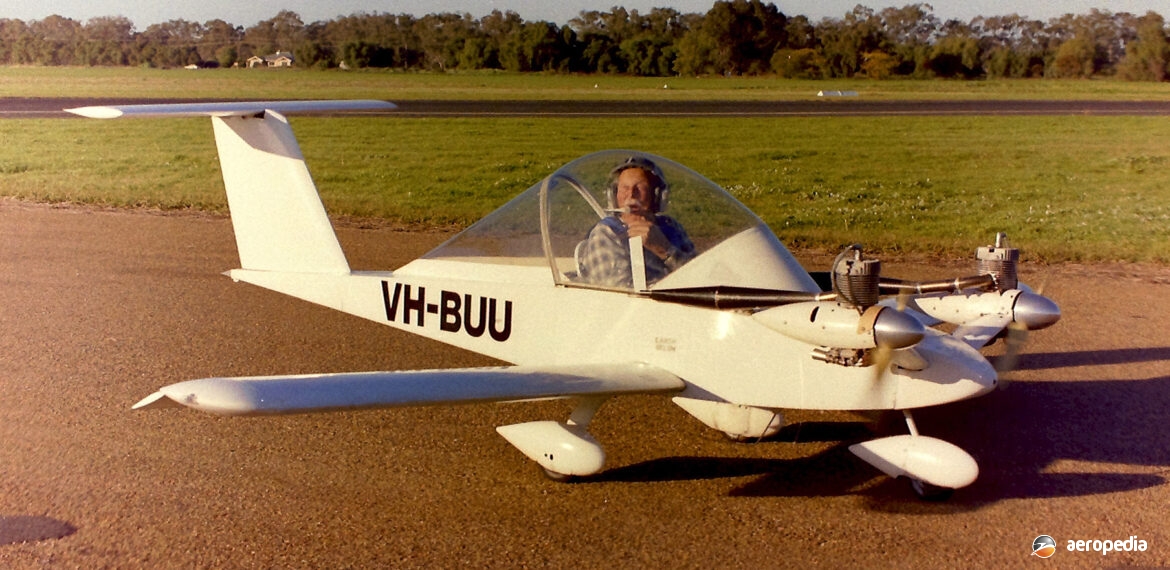Photograph:
Colomban MC-15 Cri Cri VH-BUU (c/n N178) flown by Robert Gibbs at Narromine, NSW in June 1990 (David C Eyre)
Country of origin:
France
Description:
Single-seat light sport twin-engine monoplane
Power Plant:
Two 11.2 kw (15 hp) JPX PUL 212 single-cylinder (212 cc) two-stroke air-cooled engines
Specifications:
- Wingspan: 4 m (16 ft 0¾ in)
- Length: 3.91 m (12 ft 10 in)
- Height: 1.2 m (3 ft 11¼ in)
- Wing area: 3.1 m² (33.4 sq ft)
- Max speed: 220 km/h (137 mph)
- Max cruising speed at 75% power: 100 km/h (124 mph)
- Stalling speed flaps down: 72 km/h (45 mph)
- Max rate of climb at sea level: 390 m/min (1,280 ft/min)
- Service ceiling: 5,000 m (16,400 ft)
- Range with max fuel: 400 km (248 miles)
- Empty weight: 80 kg (176 lb)
- Loaded weight: 170 kg (375 lb)
History:
The prototype of the Colomban Cri Cri series, known as the MC-10, was flown for the first time on 19 July 1973 powered by two 136 cc Rowena 6507J single-cylinder two-stroke engines, and was claimed to be the “smallest twin-engine aeroplane flying” and “the only aircraft able to lift a useful load equivalent to 170 per cent of its own empty weight”.
Subsequently a number of refinements were made to the design and these resulted in a number of models becoming available, mainly differing in the type of power plant fitted. Development flying revealed the ability to perform some aerobatics, including rolls, reversements, split-S manoeuvres, and inverted flight; and speeds up to 250 km/h (155 mph) were obtained.
A variety of small power plants have been fitted, including two 175 cc McCulloch MC-101 single-cylinder two-stroke engines; Valmet 160J engines (with which it was known as the MC-12); and the JPX PUL212 engines (with which it was known as the MC-15).
In 1981 two appeared at the Experimental Aircraft Association (EAA) event at Oshkosh in Wisconsin in the US where they received the “Designers Award”.
The type became popular throughout the world because of its cheapness of construction and economical running costs. A few have been built in Australia, first completed being VH-BUU (c/n N178) in 1988, constructed and flown by well known World War II fighter pilot and Gibbes Sepik Airways founder, Robert ‘Bobby’ Gibbes, this aircraft being built in the loungeroom at his home and test flying being carried out at Narromine, NSW.
An example completed in Western Australia as VH-ZSE (c/n SD-2) with piston engines was later re-engined with two small jet engines. A further example was registered in May 2003, this machine becoming VH-CRI (c/n 12-0078) having been built by Wayne Butt. Another example became VH-INJ (c/n 683) to its owner at Colo Vale, NSW on 7 February 2019.
First completed in New Zealand was built by Neville Hay, becoming ZK-LBW (c/n 12-0335) at Auckland. Another example was completed in New Zealand in 2011, becoming ZK-ZSE (c/n SD1). This aircraft was built by Messrs Sakkie Van Heerden and David Boles in 2011 and was first flown on 18 February 2012, later being modified to take two small jet engines.
In France examples have also been flown with two small turbojets. Aero Composites Saintonge and the Green Cri Cri Association developed a variant of the Cri Cri in France fitted with four electric engines, this aircraft making its first flight on 2 September 2010 at Le Bourget Airport near Paris. These engines used the latest technology, using brushless electric motors with counter-rotating propellers, and using high energy density lithium batteries.

